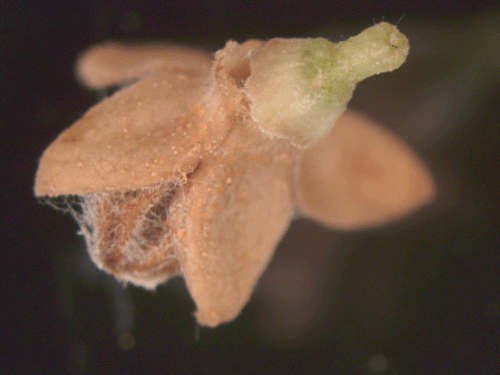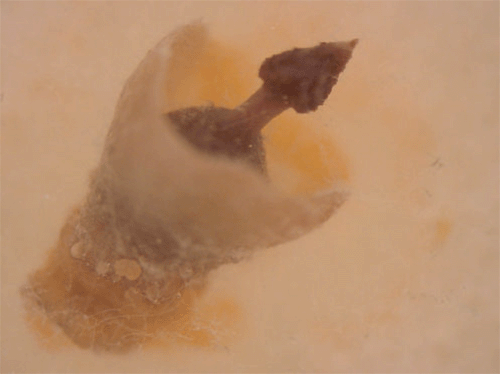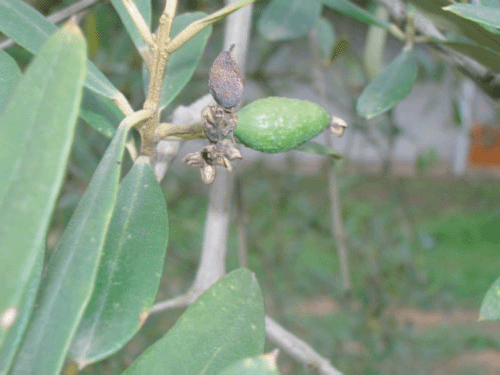Evidence of early flower infection in olives (Olea europaea) by Colletotrichum acutatum and C. gloeosporioides causing anthracnose disease
V. Sergeeva A B , N. G. Nair A and R. Spooner-Hart AA Centre for Plant and Food Science, University of Western Sydney, Locked Bag 1797, South Penrith DC, NSW 1797, Australia.
B Corresponding author. Email: v.sergeeva@uws.edu.au
Australasian Plant Disease Notes 3(1) 81-82 https://doi.org/10.1071/DN08032
Submitted: 21 April 2008 Accepted: 16 June 2008 Published: 1 July 2008
Abstract
New evidence is provided for early asymptomatic infection of flowers of olive varieties Barnea and Manzanillo by Colletotrichum acutatum and C. gloeosporioides. Asymptomatic infection of olive flowers by these species of Colletotrichum and the likely quiescent behaviour of the pathogens resulting in symptomatic disease expression of mature fruits has not been recorded anywhere previously.
We present new evidence for early asymptomatic infection of flowers of olive varieties Barnea and Manzanillo by Colletotrichum acutatum J.H. Simmonds and C. gloeosporioides (Penzig.) Penzig & Saccardo, in Australia. Incubation of the surface-sterilised flowers showed that they were infected from early stages of flowering until fruit set and that the fungi were present in calyx, petals, stamens and pistil (Figs 1 and 2). In some instances the pedicels were also infected. The first external symptoms occurred after fruit set on immature fruits when they were at peppercorn (2–4 mm) and pea (5–10 mm) sizes (Fig. 3). Some fruit drop can occur at both these stages and the fruits that remain on the trees can exhibit sporulating colonies of C. acutatum and C. gloeosporioides. We suggest that spores from these fungal colonies could be important sources for secondary infection of mature fruits. Flower infection has an important bearing on the type and timing of application of fungicides to manage anthracnose. C. acutatum expresses different pathways in the epidemiology of anthracnose disease in other crops. For instance, the pathogen is known to infect only petals in citrus flowers where they produce acervuli and cause blossom blight (Lahey et al. 2004). Anthracnose caused by C. acutatum and C. gloeosporioides is a common, widespread disease of olives in most olive-growing regions in the world, causing pre- and post-harvest problems. Infection of flowers leading to fruit rot is of economic importance as anthracnose results in significant losses in yield (Talhinhas et al. 2005) and in the quality of oil produced from fruits infected with C. gloeosporioides (Iannota et al. 1999).

|

|

|
Isolation of the fungi was carried out by collecting flowers from mature (8–10-year-old) olive trees (Barnea and Manzanillo) with a case history of anthracnose disease. The trees were located in three NSW groves, Laguna (32.995°S, 151.134°E), Menangle (34.123°S, 150.743°E) and Richmond (33.598°S, 150.751°E). C. acutatum and C. gloeosporioides were isolated by surface-sterilising flowers with 1% sodium hypochlorite for 2 min followed by washing three times in sterile distilled water. The flowers were placed on potato dextrose agar in 80-mm Petri dishes and incubated for 2 days at 25°C. They were then examined for the presence of the fungi under a light microscope at ×40 magnification. The isolates of C. acutatum from Barnea and Manzanillo were deposited in the New South Wales Plant Pathology Herbarium as DAR78874 and DAR78876, respectively, and that of C. gloeosporioides from Manzanillo as DAR78875.
Pathogenicity tests on flowers were carried out in the laboratory as well as in the field. Axenic cultures of C. acutatum and C. gloeosporioides were used in these tests. The laboratory tests involved collecting 20 flowers before the cap fall stage, surface-sterilising them as before, and placing them equidistantly on 0.1% water agar in 80-mm Petri dishes. Five replicates were used for each isolate. Suspensions of conidia (4 × 106 spores/mL) were prepared in sterile distilled water using 14-day-old cultures of the fungi. The flowers were sprayed with the spore suspensions at a rate of 1 mL per Petri dish using a Potter Precision Spray Tower. Sterilised water without conidia served as a control. The inoculated flowers were placed in an incubator at 25°C for 2 days and the percentage infection was determined. Pathogenicity tests in the field were carried out on mature flower clusters (bunches) of variety Manzanillo. Spore suspensions were prepared as before and used as inoculum for spraying the clusters. The sprayed clusters were covered with plastic bags immediately after inoculation. Flower clusters sprayed with sterile distilled water served as controls. Three clusters were used for each fungal isolate of C. acutatum and C. gloeosporioides. The flowers were collected 24 h after inoculation and placed on wet filter paper in Petri dishes and incubated at 25°C. The flowers were examined for infection after 2 days and percentage infection was calculated. All flowers were infected (100%). The laboratory and field tests confirmed the pathogenicity of both species.
The occurrence of natural infection of flowers by C. acutatum and C. gloeosporioides was relatively low (1 to 3%) in different olive varieties and locations of olive orchards during the 2006 and 2007 seasons.
As far as we are aware, asymptomatic infection of olive flowers by these species of Colletotrichum and the likely quiescent behaviour of the pathogens resulting in symptomatic disease expression of mature fruits have not been recorded previously in Australia or elsewhere.
Acknowledgements
This work was part of a project funded by Horticulture Australia Limited, NuFarm Australia and Boundary Bend Management, Boort.
Iannota N,
Perri E,
Serinni R, Tocci C
(1999) Influence of Colletotrichum gloeosporioides (Penz.) and Camarosporium dalmatica (Thum) attacks on olive quality. Acta Horticulturae 474, 573–576.

Lahey K,
Yuan R,
Burns J,
Ueng P,
Timmer L, Chung K
(2004) Inductions of phytohormones and differential gene expression in citrus flowers infected by the fungus Colletotrichum acutatum. Molecular Plant-Microbe Interactions 17, 1394–1401.
| Crossref | GoogleScholarGoogle Scholar | PubMed |

Talhinhas P,
Sreenivasaprasad S,
Neves-Martin J, Oliveira H
(2005) Molecular and phenotypic analyses reveal association of diverse Colletotrichum acutatum groups and a low level of C. gloeosporioides with olive anthracnose. Applied and Environmental Microbiology 71, 2987–2998.
| Crossref | GoogleScholarGoogle Scholar | PubMed |



